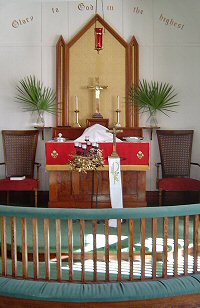It was 2000 years ago. Jesus of Nazareth had told His disciples that He was going to Jerusalem to be killed by the authorities of the time. He understood from the prophecies in what we call the "Old Testament" that He would die at the hand of the Gentiles. His disciples couldn't believe it, and some actually tried to tell Him flat out that He was wrong on this one. But Jesus was not dissuaded. He led His group to Jerusalem. The full story is recounted in the first four books of what we call the "New Testament."
 The Sunday we call "Palm Sunday" was the day that many in Jerusalem recognized Jesus as special, a kind of king, a triumphant "Messiah." People took off cloaks and tore branches off trees, placed them on the road, to make an honored way for Him. That was the first day of the week.
The Sunday we call "Palm Sunday" was the day that many in Jerusalem recognized Jesus as special, a kind of king, a triumphant "Messiah." People took off cloaks and tore branches off trees, placed them on the road, to make an honored way for Him. That was the first day of the week.
By Thursday the power establishment had calculated how it could rid the country of Jesus, because it saw Him as a trouble-maker and potential threat to its authority. It is that evening that Jesus gives the disciples that admonition to "love one another." "Maundy Thursday" commemorates this in the church year--"Maundy" comes from the Latin word for "command."
So Jesus gives a command to be loving. Meanwhile the power structure? They have hatched a plot and recruited one of Jesus' own disciples, Judas Iscariot. With Judas' help they grab Jesus on the night of Maundy Thursday, conduct an illegal night trial, and hand Him over to the Roman establishment early Friday morning, demanding that Jesus be executed. It is a "hurry, hurry" affair.
The Gentile Roman military governor, Pontius Pilate, caves in to the Jerusalem power structure demands as he sees a near riot developing, has Jesus executed on an ancient execution device we call a cross, and posts a statement of Jesus' crime above Jesus' head on that cross. It reads, "Jesus of Nazareth, King of the Jews."
Some Christian crosses today have the letters "INRI" inscribed on the cross. They represent the first letters for these words in Greek, the "universal" trade language of the time. The word "Jesus" begins with an "I" in Greek, as does the word "Jews." In Latin, the word for "king" is "rex," and hence the "R."
Jesus died on the cross in about six hours. It was a Friday. It was an evil and bad day for Jesus, but it was a "Good Friday" for mankind. The Bible teaches that Jesus Christ was the perfect sacrifice which pays the price of sin, the sin that has been mankind's burden since the Garden of Eden. Jesus was clinically and verifiably dead when they removed Him from the cross. He was dead and buried!
BUT, on the following Sunday, the day we call "Easter Sunday," Jesus is alive again, raised from death in a way that we do not understand! Not only was He alive again, but He interacted with His disciples for weeks afterward, one time with as many as 500 at that time. The Easter morning proclamation used in many churches proclaims the fact. The pastor shouts, "Christ is risen!" The congregation responds, "He is risen indeed!"
As Christians we both remember Jesus and honor Him during the week following Palm Sunday. We call it "Holy Week," because something that is "holy" has been set aside for a special purpose. Our purpose? To remember Jesus and to worship Him and our Heavenly Father Who together fulfilled the plan to save mankind from its sin and restore a lost man-God relationship which was in place before mankind's fall into sin. This might be a good time to pick up a Bible and read the Gospel of Matthew, Mark, Luke, or John, to get a closer look at Jesus Christ, the Messiah. Or, try worship on for size at a church close to you this Holy Week. Zion Lutheran Church in beautiful Silverhill worships on Palm Sunday and Easter Sunday at 10 AM, April 5 and 12. Special worship opportunities on Maundy Thursday and Good Friday, April 9 and 10, are at 7 PM.